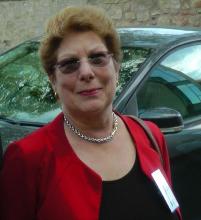“One person’s terrorist is another person’s freedom fighter,” so the saying goes. So how exactly do we spot a terrorist, John asks? The word “terrorist” is a contested term, says Ken, and thus it is philosophically useless. John says we can shape the word into something useful by highlighting the root word “terror.” But by that definition – an act of terror is a terrorist act-, what’s the difference between a terrorist and a mass murderer, asks Ken? John is thinking of terrorism being a means of achieving a political goal. But Ken is not convinced - don’t freedom fighters have a political goal in mind too? John argues that terrorism is a technique, and the cause it promotes can be different; World War 2 is taken as an example. But the terrorists from the past differ from the ones of the modern day, and after some discussion, Ken also fears that John could possibly be denying that terrorism is an intrinsically bad thing. Sane people don’t engage in terrorist techniques unless there are extenuating circumstances. But, suggests John, prior to committing their acts, terrorists are ordinary people. Ken doesn’t buy it – nobody in their right, rational mind commits a terrorist atrocity. John wonders what exactly it is to be rational. Ken and John both consider: are acts of terrorism always motivated by crazy beliefs and desires?
John and Ken introduce Martha Crenshaw, Senior Fellow at the Freeman Spogli Institute for International Studies, Professor, by courtesy, of Political Science at Stanford University, and author of Explaining Terrorism: Causes, Processes, and Consequences. John asks Martha what got her interested in the psychology of terrorists, and Martha explains that during graduate school, she encountered a book that said “nobody’s really studied terrorism,” so she decided to take the reins. By now there must be numerous studies on what makes terrorists tick, says John, and Martha agrees that there have; how sound these studies are is another matter. And is there a profile for terrorists? TSA has a behavioral profile of terrorists, not a psychological one, explains Martha, and really there is no checklist for who is a terrorist and who is not – it’s a line that is fine to draw prior to an attack. Martha agrees with John that the bias is in the eye of the beholder in terms of who is a terrorist and who is a freedom fighter. Then, when we say somebody is a terrorist, we mean a number of different things – the person who blew himself and others up, the person who told him to go do that, the person who raised money for the terrorist organization. Why would there be a single personality profile given the many different types of terrorists that there are?
Often times, terrorists are normal, intelligent people, people who don’t exhibit any kind of psychiatric disorder, and there are studies to back this up, explains Martha. These sorts of studies show that, for example, suicide bombers tend to be followers rather than leaders, people who are easily convinced, just like millions of individuals in the world. But, Ken says, that is an extreme followership and willingness to be a pawn, and so there’s something not quite normal about that. Martha thinks it’s a vain hope to think that even this extreme nature is abnormal. Martha talks about lone wolves versus organized activity – gangs of sorts, as Ken says - as was the case with 9/11.
John, Ken, and Martha continue the discussion of what makes a terrorist by welcoming audience participation live from the Marsh Theater in Berkeley. They respond to questions ranging from whether attacks on the military are considered terrorism to whether terrorism is moral and whether the ends justify the means, and touch on the politics of power and matters of terrorism as a form of repression.
- Roving Philosophical Reporter (Seek to 7:12): Caitlin Esch talks to Clark McCauley, the Rachel C. Hale Professor of Sciences and Mathematics and co-director of the Solomon Asch Center for Study of Ethnopolitical Conflict at Bryn Mawr College, about the different kinds of lone wolf terrorists that exist. Lone wolf terrorists differ from those who join militant groups, and include the “caring compelled” type.
- 60-Second Philosopher (Seek to 46:55): Ian Shoales speeds through the violent tale of Jesse and Frank James – ruthless American rebels and robbers.




Comments (1)
ANelson
Thursday, November 23, 2023 -- 3:39 AM
This dialogue delves into theThis dialogue delves into the complexities of defining terrorism and understanding the psychology behind it, providing valuable information for a comprehensive military essay. Perspectives offered by experts such as Martha Crenshaw and Clark McCauley, as well as historical references to the James brothers as American rebels and robbers, add layers to the discussion, demonstrating the diverse aspects and motivations behind acts of violence often classified as terrorism. This comprehensive study is invaluable for a detailed understanding of the field of military research, which can be ordered at military essay service.